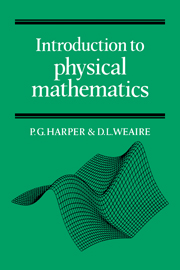Book contents
- Frontmatter
- Contents
- Preface
- Some notes on notation
- 1 Introduction
- 2 Errors
- 3 Cartesian coordinates
- 4 Vectors
- 5 The scalar product
- 6 The vector product and rotation
- 7 Matrices in physics
- 8 The transformation of matrices
- 9 The matrix eigenvalue equation
- 10 Exponential and logarithm functions
- 11 Sine and cosine functions
- 12 Graph plotting and curve sketching
- 13 Differentiation
- 14 Approximations
- 15 Power series and Taylor's expansion
- 16 Partial differentiation
- 17 Integration
- 18 The differential equation
- 19 Solving first-order differential equations
- 20 Second-order differential equations
- 21 Solving second-order differential equations
- 22 The complex exponential
- 23 The circuit equation
- 24 Harmonics and Fourier series
- 25 The diffusion equation
- 26 Waves
- 27 The rate of change of a vector
- 28 The scalar field and gradient operator
- 29 The vector field
- 30 Line integration
- 31 The potential field
- 32 Surface and volume integration
- 33 Flux and divergence
- 34 Circulation and the curl
- 35 Conclusion
- 36 Miscellaneous exercises
- Index
29 - The vector field
Published online by Cambridge University Press: 20 October 2009
- Frontmatter
- Contents
- Preface
- Some notes on notation
- 1 Introduction
- 2 Errors
- 3 Cartesian coordinates
- 4 Vectors
- 5 The scalar product
- 6 The vector product and rotation
- 7 Matrices in physics
- 8 The transformation of matrices
- 9 The matrix eigenvalue equation
- 10 Exponential and logarithm functions
- 11 Sine and cosine functions
- 12 Graph plotting and curve sketching
- 13 Differentiation
- 14 Approximations
- 15 Power series and Taylor's expansion
- 16 Partial differentiation
- 17 Integration
- 18 The differential equation
- 19 Solving first-order differential equations
- 20 Second-order differential equations
- 21 Solving second-order differential equations
- 22 The complex exponential
- 23 The circuit equation
- 24 Harmonics and Fourier series
- 25 The diffusion equation
- 26 Waves
- 27 The rate of change of a vector
- 28 The scalar field and gradient operator
- 29 The vector field
- 30 Line integration
- 31 The potential field
- 32 Surface and volume integration
- 33 Flux and divergence
- 34 Circulation and the curl
- 35 Conclusion
- 36 Miscellaneous exercises
- Index
Summary
A vector field is a vector function of position. Such a function is used in physics to describe the force F on a particle, due to interaction with other particles, which contribute to the total field experienced by the particle according to such force laws as Coulomb's law. It is also basic to fluid dynamics in which the local velocity v of fluid flow is a function of position r.
In certain branches of physics and engineering the computation of vector fields offers the rewards and status of a career. For example aircraft designers need immense detail of air current/pressures and stress distributions of air frames and must compute and plot out vector fields of great complexity. General methods of systematic calculation are still the subject of mathematical research.
Let us look first at the case of a force field, using the particle-in-a-bowl problem of chapters 20 and 27 as our example. In the equation dv/dt = – ω2r, the right-hand side can be regarded as the vector function F(r) = – ω2r. This is the force that would act on a unit mass at r. The time variable is absent from this expression which describes a static field. The properties of a vector field can be studied without any immediate reference to particle motion.
To express the Coulomb field due to a point charge, fixed arbitrary axes may be chosen with the charge (positive, say) at the origin, x = y = z = 0.
Information
- Type
- Chapter
- Information
- Introduction to Physical Mathematics , pp. 206 - 211Publisher: Cambridge University PressPrint publication year: 1985
